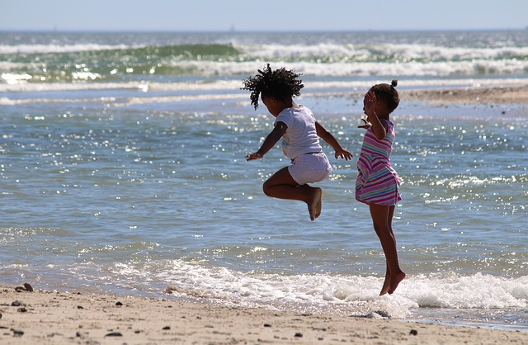Hop smart!
“Easy as pie - eat better. More exercise” includes programs for overweight children. Sufficient exercise and a balanced diet are important for all children: the little ones learn and experience themselves and the world in which they live, through physical exercise and perception, with all their senses.
For example, they can only cope with the rather complicated coordination of eye and hand, which is later necessary for writing if they have intensive movement experiences. So our children need more exercise and better food at the same time - two demands that could be met in the truest sense of the word if they simply gave their natural urge to move, explore and discover more space.
Children are not small adults
Children need “free” play times with their peers for romping and climbing and for ball and bounce games - in summer they prefer to play outdoors. As if by themselves, they learn to fit into a group. They can test the limits of their capabilities, experience gravity and balance on their own bodies, and thus gain confidence in the abilities of their bodies.
Experience Food & Drink
What applies to movement also applies to food: Tasting what tastes like, discovering when hunger and thirst are satisfied, experiencing regular meals together and helping to prepare them practically these are not spectacular measures, but they are successful. They stabilise the eating behaviour of our children and their weight playfully, lightly. It is also essential to make it possible to experience where the food comes from, e.g. to see fruit and vegetables growing up in your own garden, to visit farms or to look behind the scenes of a bakery or butcher’s shop.
“More” is more
“Children and watches must not be wound. You also have to let them go,” pondered the Franconian pedagogue and poet Jean Paul (1763-1825). So if we give our children more time for their original urge to discover and move, and if we give them the pleasure of good food and drink in the community, their healthy physical and mental development will require neither sophisticated therapy programs nor special children’s foods.
Running, climbing, jumping…
- it’s fun, and it’s good humour. There are thousands of simple game ideas, they have handed many of which down from generation to generation. Popular are all kinds of ball games, whether alone, in pairs or in a group, and fishing games - e.g. the magic tree: All children run. A child is the catcher. As soon as it has touched another child, this remains rooted like a tree. Any other child who has not yet been captured can free the child by touching the palm of his hand, so that the child can continue to run, be captured again or release other children from the magic tree stage.
Rope jumping: You need a strong rope whose length reaches under the armpits on both sides when you stand with your feet on its middle part. We’re ready to go: Swing one end of the rope in each hand and the rope over your head from back to front. As soon as it touches the ground again, you either jump with both legs at the same time or run over it, swing, jump, swing, jump in the same time - and shouldn’t give up if it doesn’t work out at the beginning. Skipping rope hopping promotes motor skills and endurance and concentration. Heaven and Hell is the name of one of the oldest hopping games that knows many variations. You only need one place, free of traffic, where you paint your bouncy boxes either with chalk or paint stone on asphalt or with sticks in earth or sand and a small stone. Here we go: Throw the stone into the first box and hop afterwards, pushing the stone one box further with your feet. So it goes on to the penultimate box - hell, which must be skipped to reach into the last heaven. What happens if this doesn’t succeed, and it can also find various variants of this exciting jumping game on the Internet.
Author: Brigitte Neumann
Tryk Databeskyttelse Billeder: www.pixabay.com

